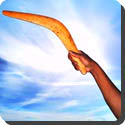 It is the built-in skew or twist in a boomerang combined with its spinning motion that makes it return to the thrower. At first people believed that air, pressing on the lower flat surface and passing over the upper rounded face, was responsible for the return flight. But T.L. Mitchell, a Scottish explorer of Australia, gave the true explanation early in the 19th Century.
It is the built-in skew or twist in a boomerang combined with its spinning motion that makes it return to the thrower. At first people believed that air, pressing on the lower flat surface and passing over the upper rounded face, was responsible for the return flight. But T.L. Mitchell, a Scottish explorer of Australia, gave the true explanation early in the 19th Century.
The curved throwing stick is used chiefly by the aborigines of Australia for hunting and warfare. (They also use a non-returning kind of boomerang.)
The boomerang is held at one end, above and behind the thrower’s shoulder, with the concave edge to the front, and swung forward rapidly with the flat side underneath. Just before it is released, it is gives extra power with a strong wrist movement.
If thrown downward or parallel to the ground it sweeps upward to a height of 50 feet or more. When thrown so that one end strikes the ground, it ricochets into the air at terrific speed, spinning endwise. It completes a circle 50 yards or more wide and then several smaller ones, up to five, before it drops to the ground near the thrower.
 Kids Portal For Parents India Kids Network
Kids Portal For Parents India Kids Network






